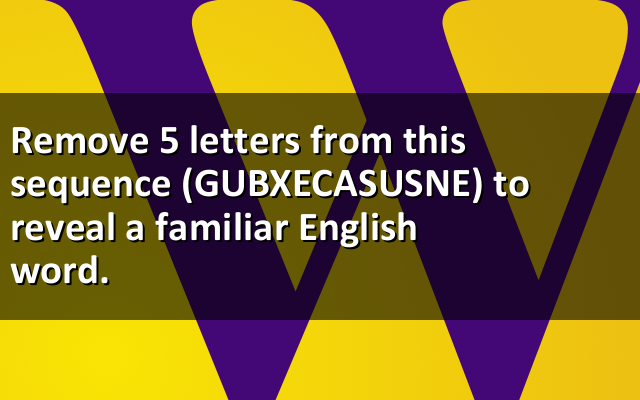Remove 5 letters from this seq...
Remove 5 letters from this sequence (GUBXECASUSNE) to reveal a familiar English word.Correct answers: 21
The first user who solved this task is Nasrin 24 T.
#brainteasers #wordpuzzles

The Lord Will Save Me!
It rained for days and days and there was a terrific flood. The water rose so high that one man was forced to climb on top of his roof and sat in the rain. As the waters came up higher a man in a rowboat came up to the house and told him to get in. "No thank you, the Lord will save me!" he said, and the man in the rowboat rowed away.
The waters rose to the edge of the roof and still the man sat on the roof until another rowboat came by and another man told him to get in. "No thank you, the Lord will save me!" he said again, and the man rowed away.The waters covered the house and the man was forced to sit on his chimney as the rain poured down and a helicopter came by and another man urged him to get in or he'll drown. "No thank you," the man said again, "The Lord will save me!"
After much begging and pleading the man in the helicopter gave up and flew away. The waters rose above the chimney and the man drowned and went to heaven where he met God.
"Lord, I don't understand," he told Him, frustrated, "The waters rose higher and higher and I waited hours for you to save me but you didn't! Why?"
The Lord just shook his head and said, "What are you talking about? I sent two boats and a helicopter?!"
The waters rose to the edge of the roof and still the man sat on the roof until another rowboat came by and another man told him to get in. "No thank you, the Lord will save me!" he said again, and the man rowed away.The waters covered the house and the man was forced to sit on his chimney as the rain poured down and a helicopter came by and another man urged him to get in or he'll drown. "No thank you," the man said again, "The Lord will save me!"
After much begging and pleading the man in the helicopter gave up and flew away. The waters rose above the chimney and the man drowned and went to heaven where he met God.
"Lord, I don't understand," he told Him, frustrated, "The waters rose higher and higher and I waited hours for you to save me but you didn't! Why?"
The Lord just shook his head and said, "What are you talking about? I sent two boats and a helicopter?!"

